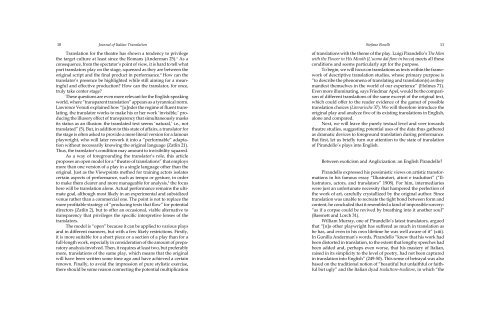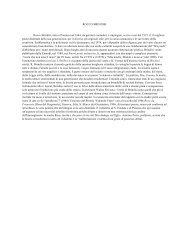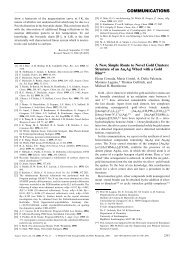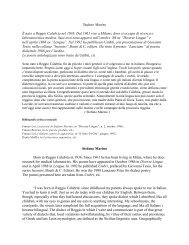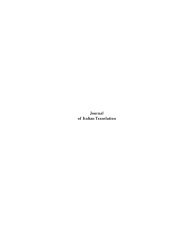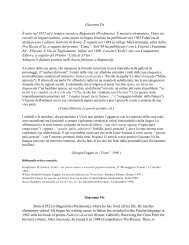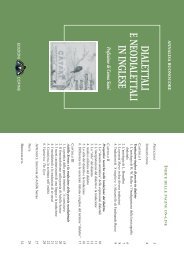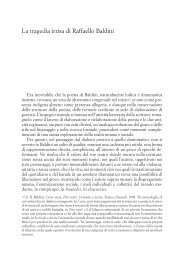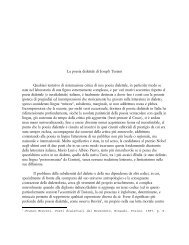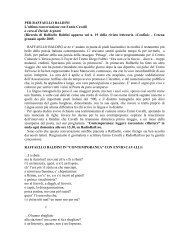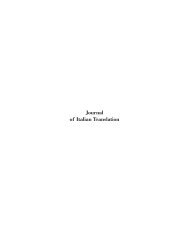Journal of Italian Translation - Brooklyn College - Academic Home ...
Journal of Italian Translation - Brooklyn College - Academic Home ...
Journal of Italian Translation - Brooklyn College - Academic Home ...
Create successful ePaper yourself
Turn your PDF publications into a flip-book with our unique Google optimized e-Paper software.
10 <strong>Journal</strong> <strong>of</strong> <strong>Italian</strong> <strong>Translation</strong><br />
Stefano Boselli<br />
11<br />
<strong>Translation</strong> for the theatre has shown a tendency to privilege<br />
the target culture at least since the Romans (Anderman 25). 1 As a<br />
consequence, from the spectator’s point <strong>of</strong> view, it is hard to tell what<br />
part translators play on the stage, squeezed as they are between the<br />
original script and the final product in performance. 2 How can the<br />
translator’s presence be highlighted while still aiming for a meaningful<br />
and effective production? How can the translator, for once,<br />
truly take center stage?<br />
These questions are even more relevant for the English-speaking<br />
world, where “transparent translation” appears as a tyrannical norm.<br />
Lawrence Venuti explained how “[u]nder the regime <strong>of</strong> fluent translating,<br />
the translator works to make his or her work ‘invisible,’ producing<br />
the illusory effect <strong>of</strong> transparency that simultaneously masks<br />
its status as an illusion: the translated text seems ‘natural,’ i.e., not<br />
translated” (5). But, in addition to this state <strong>of</strong> affairs, a translator for<br />
the stage is <strong>of</strong>ten asked to provide a mere literal version for a famous<br />
playwright, who will later rework it into a “performable” adaptation<br />
without necessarily knowing the original language (Zatlin 21).<br />
Thus, the translator’s condition may amount to invisibility squared.<br />
As a way <strong>of</strong> foregrounding the translator’s role, this article<br />
proposes an open model for a “theatre <strong>of</strong> translations” that employs<br />
more than one version <strong>of</strong> a play in a single language other than the<br />
original. Just as the Viewpoints method for training actors isolates<br />
certain aspects <strong>of</strong> performance, such as tempo or gesture, in order<br />
to make them clearer and more manageable for analysis, 3 the focus<br />
here will be translation alone. Actual performance remains the ultimate<br />
goal, although most likely in an experimental and subsidized<br />
venue rather than a commercial one. The point is not to replace the<br />
more pr<strong>of</strong>itable strategy <strong>of</strong> “producing texts that flow” for potential<br />
directors (Zatlin 2), but to <strong>of</strong>fer an occasional, viable alternative to<br />
transparency that privileges the specific interpretive lenses <strong>of</strong> the<br />
translators.<br />
The model is “open” because it can be applied to various plays<br />
and in different manners, but with a few likely restrictions. Firstly,<br />
it is more suitable for a short piece or a section <strong>of</strong> a play than for a<br />
full-length work, especially in consideration <strong>of</strong> the amount <strong>of</strong> preparatory<br />
analysis involved. Then, it requires at least two, but preferably<br />
more, translations <strong>of</strong> the same play, which means that the original<br />
will have been written some time ago and have achieved a certain<br />
renown. Finally, to avoid the impression <strong>of</strong> pure stylistic exercise,<br />
there should be some reason connecting the potential multiplication<br />
<strong>of</strong> translations with the theme <strong>of</strong> the play. Luigi Pirandello’s The Man<br />
with the Flower in His Mouth (L’uomo dal fiore in bocca) meets all these<br />
conditions and seems particularly apt for the purpose.<br />
To begin, we will focus on translations as texts within the framework<br />
<strong>of</strong> descriptive translation studies, whose primary purpose is<br />
“to describe the phenomena <strong>of</strong> translating and translation(s) as they<br />
manifest themselves in the world <strong>of</strong> our experience” (Holmes 71).<br />
Even more illuminating, says Friedmar Apel, would be the comparison<br />
<strong>of</strong> different translations <strong>of</strong> the same excerpt <strong>of</strong> the original text,<br />
which could <strong>of</strong>fer to the reader evidence <strong>of</strong> the gamut <strong>of</strong> possible<br />
translation choices (Literarische 37). We will therefore introduce the<br />
original play and analyze five <strong>of</strong> its existing translations in English,<br />
alone and compared.<br />
Next, we will leave the purely textual level and veer towards<br />
theatre studies, suggesting potential uses <strong>of</strong> the data thus gathered<br />
as dramatic devices to foreground translation during performance.<br />
But first, let us briefly turn our attention to the state <strong>of</strong> translation<br />
<strong>of</strong> Pirandello’s plays into English.<br />
Between exoticism and Anglicization: an English Pirandello?<br />
Pirandello expressed his pessimistic views on artistic transformations<br />
in his famous essay “Illustratori, attori e traduttori” (“Illustrators,<br />
actors, and translators” 1908). For him, intermediaries<br />
were just an unfortunate necessity that hampered the perfection <strong>of</strong><br />
the work <strong>of</strong> art, carefully crystallized by the original author. Since<br />
translation was unable to recreate the tight bond between form and<br />
content, he concluded that it resembled a kind <strong>of</strong> impossible sorcery:<br />
“as if a corpse could be revived by breathing into it another soul”<br />
(Bassnett and Lorch 31).<br />
William Murray, one <strong>of</strong> Pirandello’s latest translators, argued<br />
that “[n]o other playwright has suffered as much in translation as<br />
he has, and even in his own lifetime he was well aware <strong>of</strong> it” (xiii).<br />
In Gunilla Anderman’s words, Pirandello “knew that his work had<br />
been distorted in translation, to the extent that lengthy speeches had<br />
been added and, perhaps even worse, that his mastery <strong>of</strong> <strong>Italian</strong>,<br />
raised in its simplicity to the level <strong>of</strong> poetry, had not been captured<br />
in translation into English” (249-50). This sense <strong>of</strong> betrayal was also<br />
based on the traditional notion <strong>of</strong> “beautiful but unfaithful or faithful<br />
but ugly” and the <strong>Italian</strong> dyad traduttore-traditore, in which “the


